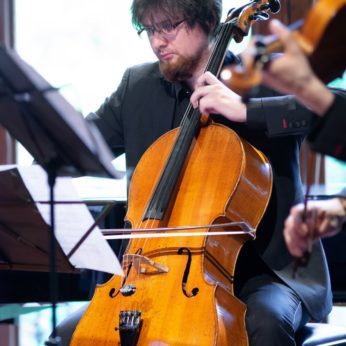Composer: Andrzej Panufnik (b. 1914 - d. 1991)
Performance date: 01/07/2018
Venue: Bantry Library
Composition Year: 1980
Duration: 00:23:35
Recording Engineer: Tom Norton, RTÉ
Instrumentation: 2vn, va, vc, pf
Instrumentation Category:String Quartet
Artists:
Apollon Musagète Quartet (Paweł Zalejski, Bartosz Zachłod [violins], Piotr Szumieł [viola], Piotr Skweres [cello]) -
[quartet]

Apollon Musagète Quartet
Pawel Zalejski, Bartosz Zachtod [violins]
Piotr Szumiet [viola]
Piotr Skzeres [cello]
Andrzej Panufnik [1914-1991]
Quartet No.2 ‘Messages’ [1980]
1. Adagio misterioso – Andante cantabile –
2. Allegretto rubato – Allegro non troppo –
3. Andante tranquillo – Più andante, molto tranquillo – Allegro non troppo –
4. Vivo scherzando – Vivace con brio – Poco meno mosso –
5. Vivace con brio – Vivacissimo, quasi senza misura – Improvvisando – Allegro non troppo –
6. Allegretto rubato –
7. Andante cantabile – Adagio misterioso
All composers share the frisson of looking at a blank piece of manuscript paper with a deadline looming large… In 1980 when commissioning String Quartet No.2 Messages for the Gabrieli Quartet and the North Wales Festival, the composer William Mathias warned my father of difficulties concerning accommodation at St Asaph, Dad wrote: it is the only time in my life I have booked a hotel room for a first performance before even putting a note on paper – several months before.
The title Messages alludes to his favourite pastime as a child on holiday in the Polish countryside: putting his ear against a wooden telegraph pole to listen to the eerie, semi-musical sounds of the wires vibrating in the wind – which he considered, in part, to be the genesis of his compositional imagination. He writes: Although I have designed a framework with a most rigorous structure, my main intention was to compose a fantasy-poem, with real musical substance, and to convey to the listener some of the mysterious messages which I used to overhear in my imagination from the telegraph poles. The work starts exactly as I remember from my childhood: from total silence through to a hardly audible chord (tetrad), gradually transformed into melodic lines, which weave throughout the work into various shades of poetical expression, returning finally to the first chord, which eventually dissolves into silence.
This Quartet, in one continuous movement, is based on just a four-note cell and a three-note cell with all their transpositions, reflections and permutations. My father likened it to a secret code – a message made up of squares and triangles rather than words.
Roxanna Panufnik
Copyright © 2024 West Cork Music. All rights reserved.
Designed and developed by Matrix Internet